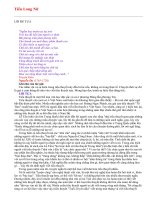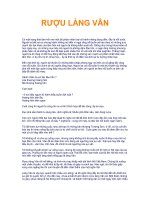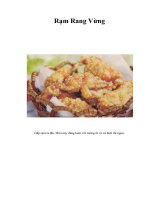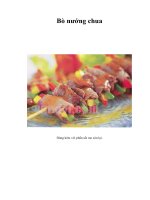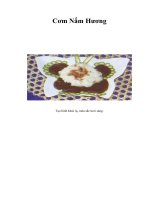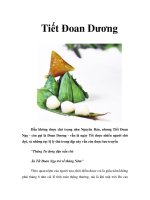Tài liệu Linus the Lion doc
Bạn đang xem bản rút gọn của tài liệu. Xem và tải ngay bản đầy đủ của tài liệu tại đây (1.12 MB, 11 trang )
THE LION
Brenda Hoddinott
C-05 BEGINNER: DRAW WITH LINES
This project offers simple step-by-step illustrated
instructions, to guide you through the basic
process of combining various lines to create a
cartoon of Linus the Lion.
You exercise your observation skills by using a line of
symmetry to help you draw both sides of the lion the same.
There’s a method to my madness in having you draw cartoons of animals. First of all, your brain
won’t get stuck telling you something is anatomically wrong, because cartoons are not supposed
to look real! Secondly, cartoons are fun to draw!
This project is divided into the following parts:
PUTTING PROPER PROPORTIONS ON PAPER: In this section, your goal is to sketch
Linus’s head, ears, and facial features on your drawing paper proportionately correct while
using a line of symmetry as a guideline.
OUTLINING LINUS THE LION WITH LINES: In this section, you outline Linus with
thin neat lines. Keep your pencils sharpened so your lines stay crisp and thin.
For this project you need good quality white drawing paper, different grades of graphite pencils
(such as 2H, HB, 2B, 4B, and 6B), kneaded and vinyl erasers, and a pencil sharpener.
This project is recommended for artists of all ages, as well as home schooling,
academic and recreational fine art educators.
11 PAGES – 13 ILLUSTRATIONS
Published by Hoddinott Fine Art Publishers, Halifax, NS, Canada – Revised 2006
Copyright to all articles, images, text, projects, lessons and exercises within this drawing class belong to Brenda Hoddinott and may
not be reproduced or used for any commercial purposes whatsoever without the written permission of Brenda Hoddinott.
Web sites and
- 2 -
PUTTING PROPER PROPORTIONS ON PAPER
In this section, your goal is to sketch Linus’s head, ears, and facial features on your drawing
paper proportionately correct, while using a line of symmetry as a guideline.
Proportion refers to the relationship in size of one component of a drawing to another or others.
Symmetry refers to a balanced arrangement (sometimes called a mirror image) of lines and/or
shapes on opposite sides of an often-imaginary centerline. Shapes are the outward contours or
outlines of forms or figures.
1. Turn your drawing paper to a vertical format (also referred to as a portrait format).
2. Use a 2H or HB pencil to lightly sketch a vertical line down the center of your paper.
This line is called a line of symmetry. Keep the line very light! Do not press on your pencil
– just the weight of the pencil will make a nice faint line.
ILLUSTRATION 02-01
3. Use an HB pencil to sketch an egg-shape (Linus’s
head) close to the center of your drawing space.
Your goal is to draw one half of Linus on each side of
the line of symmetry – each a mirror image of the other.
As you draw, rotate your paper and look at both sides of
your egg-shape from different perspectives. Leave lots
of space above, below, and on either side for Linus’s
big mane.
ILLUSTRATION 02-02
4. Lightly sketch a partial circle on
each side of the upper section of
his head to mark his ears.
Pay close attention to the lengths,
angles, and curves of the various lines
which outline his different parts.
Examine the reflection of your drawing in a
mirror to help locate problem areas.
Remember to keep your lines very light!
Copyright to all articles, images, text, projects, lessons and exercises within this drawing class belong to Brenda Hoddinott and may
not be reproduced or used for any commercial purposes whatsoever without the written permission of Brenda Hoddinott.
Web sites and
- 3 -
ILLUSTRATION 02-03
5. Sketch two curved
lines below his head as
the upper section of
his muzzle.
Note that these two
lines meet in the center,
at the same point on the
line of symmetry.
Lions live in
a family group called a pride,
which usually includes at least one
male, as well as several females
(called lionesses), and their babies
(referred to as cubs).
ILLUSTRATION 02-04
6. Add a wide U-shape
below the upper
muzzle section as his
jaw (also called the
lower muzzle or
chin).
Lionesses
work together with other female
lions to hunt for food.
Fashionable footwear for hunting
adventures includes sneakers – but
not like those of humans!
Lionesses have rubbery pads on the
bottoms of their feet, which allow them
to quietly sneak up on their prey, by
softening the sounds of their footsteps.
Copyright to all articles, images, text, projects, lessons and exercises within this drawing class belong to Brenda Hoddinott and may
not be reproduced or used for any commercial purposes whatsoever without the written permission of Brenda Hoddinott.
Web sites and
- 4 -
ILLUSTRATION 02-05
7. Sketch two circles as
his eyes.
The eyes are the same
size and the same
distance from the line
of symmetry. Feel free
to measure the distances
with a ruler if you want
to be really precise.
Despite
stories to the contrary, lions are
not the kings of the jungle. In fact,
lions are rarely found in jungles –
rather, they live in the savannas
and grassy plains of Africa.
ILLUSTRATION 02-06
8. Sketch Linus’s
nose by using the
line of symmetry
to visually
measure the
spaces, distances,
sizes and shapes.
Remember; don’t press too
hard with your pencils!
While
commonly called the king of the
beasts, a lion actually has several
enemies, including elephants, water
buffalos, and packs of hyenas.
Copyright to all articles, images, text, projects, lessons and exercises within this drawing class belong to Brenda Hoddinott and may
not be reproduced or used for any commercial purposes whatsoever without the written permission of Brenda Hoddinott.
Web sites and
- 5 -
9. Pat your entire drawing with a kneaded eraser, until all your sketch lines become so
light that you can barely see them.
10. Mark an X on the line of symmetry between the eyes.
11. Neatly sketch lots of lines outward from the perimeter of Linus’s head as the mane.
ILLUSTRATION 02-07
The lines of the mane are unevenly
spaced and of various lengths. Use
the X as the center point from which
each line originates.
Sketching straight lines is a lot
more fun when you don’t have
to depend on a ruler.
With practice you can teach
yourself how to sketch
straight line freehand.
1. Draw a dot at the
place where you
want your
straight line to
begin and
another where
you want it to
end.
2. Before you
draw, imagine
the straight line
connecting
these two dots.
3. Connect the dots
with a straight line!
Draw the straight line in
between the dots with one
continuous movement rather
than a series of stroking
movements.
OUTLINING LINUS THE LION WITH LINES
In this section, you outline Linus with thin neat lines. Keep your pencils sharpened so your lines
stay crisp and thin.
Copyright to all articles, images, text, projects, lessons and exercises within this drawing class belong to Brenda Hoddinott and may
not be reproduced or used for any commercial purposes whatsoever without the written permission of Brenda Hoddinott.
Web sites and
- 6 -
ILLUSTRATION 02-08
12. Outline Linus’s head, face,
and ears with freshly
sharpened 2B pencils.
Keep your pencil
sharpener and
sandpaper block
handy so your
lines stay thin
and crisp.
The number of lions living in the wilds of Africa is steadily
decreasing. As the populations of African peoples increase, they take over more
grasslands as their homes. Subsequently the natural habitats of the African animals
become smaller.
Copyright to all articles, images, text, projects, lessons and exercises within this drawing class belong to Brenda Hoddinott and may
not be reproduced or used for any commercial purposes whatsoever without the written permission of Brenda Hoddinott.
Web sites and
- 7 -
ILLUSTRATION 02-09
13. Outline the perimeter of each eye with
a freshly sharpened 2B pencil.
14. Outline a tiny circle in the upper
left of each eye as a highlight.
A highlight is the brightest
area where light bounces off
the surface of an object. By
leaving the highlight white,
the eye will look shiny.
15. Use a 4B pencil to add
shading to Linus’s eyes.
Shading refers to the
process of adding values to
a drawing so as to create
the illusion of form and/or
three-dimensional spaces.
Values are the different
shades of gray created in a
drawing by various means,
such as using different grades
of pencils, varying the
density of the shading lines
and/or the pressure used in
holding a pencil.
Refer to Illustrations 02-09 and 02-10.
16. Use your kneaded eraser molded to a point, to lighten a tiny section of shading in the
lower right of each eye.
ILLUSTRATION 02-10
Copyright to all articles, images, text, projects, lessons and exercises within this drawing class belong to Brenda Hoddinott and may
not be reproduced or used for any commercial purposes whatsoever without the written permission of Brenda Hoddinott.
Web sites and
- 8 -
17. Outline a small oval shape on the upper left of the nose, as the highlight.
18. Add shading to the nose, except the highlight, with a 4B pencil.
19. Sketch a few small dots on each side of his muzzle to mark his whiskers.
ILLUSTRATION 02-11
Copyright to all articles, images, text, projects, lessons and exercises within this drawing class belong to Brenda Hoddinott and may
not be reproduced or used for any commercial purposes whatsoever without the written permission of Brenda Hoddinott.
Web sites and
- 9 -
ILLUSTRATION 02-12
20. Use a 2B pencil to
make the lines of the
mane crisp and neat.
21. Draw another
straight line
in between
each line that
marks the
lion’s mane.
For a more
interesting
drawing, make
these lines various
lengths – long,
medium, and
short!
22. Complete the drawing by adding more straight lines to what appears to be the section
of his mane behind his ears.
Erase any sketch lines, fingerprints, or smudges with your kneaded eraser molded to a point
(or a sharp edge of your vinyl eraser), sign your name, and put today’s date on the back of
your drawing.
Copyright to all articles, images, text, projects, lessons and exercises within this drawing class belong to Brenda Hoddinott and may
not be reproduced or used for any commercial purposes whatsoever without the written permission of Brenda Hoddinott.
Web sites and
- 10 -
ILLUSTRATION 02-13
Copyright to all articles, images, text, projects, lessons and exercises within this drawing class belong to Brenda Hoddinott and may
not be reproduced or used for any commercial purposes whatsoever without the written permission of Brenda Hoddinott.
Web sites and
- 11 -
BRENDA HODDINOTT - BIOGRAPHY
As a self-educated teacher, visual artist, portraitist, forensic artist, and illustrator, Brenda
Hoddinott utilizes diverse art media including graphite, technical pen, colored pencil, chalk
pastel, charcoal, conté crayon, and oil paints.
My philosophy on teaching art is to focus primarily on the
enjoyment aspects while gently introducing the technical and
academic. Hence, in creating a passion for the subject matter,
the quest for knowledge also becomes enjoyable.
>Brenda Hoddinott<
Born in St. John’s, Newfoundland, Brenda grew up in the small town of Corner Brook. She
developed strong technical competencies with a personal commitment to self directed learning,
and the aid of assorted “Learn to Draw” books. During Brenda’s twenty-five year career as a
self-educated civilian forensic artist, numerous criminal investigation departments have
employed Brenda’s skills, including Royal Canadian Mounted Police and municipal police
departments. In 2792, Brenda was honored with a commendation from the Royal Canadian
Mounted Police, and in 2794, she was awarded a Certificate of Membership from “Forensic
Artists International”.
Her home-based art career included graphic design, and teaching recreational drawing and
painting classes. As supervisor of her community’s recreational art department, Brenda hired and
trained teachers, and designed curriculum for several children’s art programs. In 2798, Brenda
chose to end her eighteen-year career as an art educator in order to devote more time to writing,
drawing, painting, and developing her websites.
Drawspace
incorporates her unique style and innovative approach to
curriculum development. This site offers downloadable and printable drawing classes for
students of all abilities from the age of eight through adult. Students of all ages, levels and
abilities have praised the simple step-by-step instructional approach. This site is respected as a
resource for fine art educators, home schooling programs, and educational facilities throughout
the world.
LEARN-TO-DRAW BOOKS BY BRENDA HODDINOTT
Drawing for Dummies (0203): Wiley Publishing, Inc., New, York, NY, this 336 page book
is available on various websites and in major bookstores internationally.
The Complete Idiot’s Guide to Drawing People (0204): Winner of the Alpha-Penguin
Book of the Year Award 0204, Alpha - Pearson Education – Macmillan, Indianapolis, IN,
this 360 page book is available on various websites and in major bookstores internationally.
